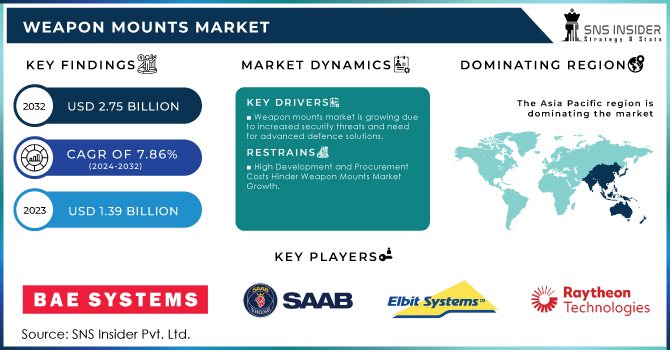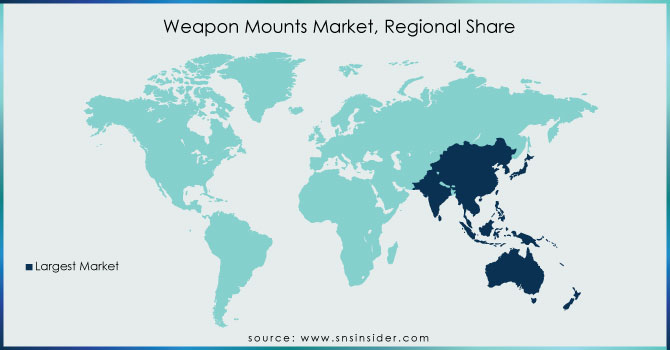Weapon Mounts Market Size:
The Weapon Mounts Market Size was valued at USD 1.39 billion in 2023, expected to reach USD 2.75 billion by 2032 with a growing CAGR of 7.86% over the forecast period 2024-2032.

To get more information on Weapon Mounts Market - Request Free Sample Report
The demand for weapon mounts is rising due to the growing need for weaponized defence vehicles. Military advancements and the adoption of sophisticated weaponry are fueling market growth. Increased security measures and defence spending by major economies further contribute to this trend. Territorial conflicts and the focus on minimal-risk operations by leading defence systems also play a positive role. Technical advancements offer both static and non-static options for operating mounted weapons. These mounts are adaptable to various weapon sizes and can be directly or remotely controlled. Leading players are introducing dynamic mounts for ground, naval, and airborne platforms. The growing emphasis on unmanned vehicles and aircraft due to defence budget increases and the avoidance of human casualties in critical areas is expected to drive demand for weapon mounts.
MARKET DYNAMICS:
KEY DRIVERS:
-
Weapon mounts market is growing due to increased security threats and need for advanced defence solutions
Growing security threats like terrorism are driving the weapon mounts market. This surge is linked to the need for better defence mechanisms. As threats become more varied, countries are focusing on strengthening their defences, which increases demand for advanced weapon mounts. These evolving threats require adaptable and strong weapon mounting systems for diverse situations and quick responses. Weapon mount manufacturers must create innovative solutions to counter these new threats.
-
Lightweight, Modular Weapon Mounts Drive Market Growth for Adaptable and Effective Defence Solutions
RESTRAINTS:
-
High Development and Procurement Costs Hinder Weapon Mounts Market Growth
High development and procurement costs are a major hurdle for the weapon mounts market. This strains both manufacturers and buyers. Designing and building advanced mounts is expensive, limiting access for smaller organizations. Military and law enforcement agencies with tight budgets may also struggle to afford them. This can lead to choosing cheaper options or delaying purchases altogether. Additionally, the high R&D costs discourage new companies from entering the market, hindering innovation.
OPPORTUNITIES:
-
Demand for weaponized drones and unmanned vehicles creates a new market for lightweight, adaptable weapon mounts.
-
Focus on remote weapon control systems increases demand for compatible and secure weapon mounts.
CHALLENGES:
-
Rising security threats like terrorism are driving demand, but also require expensive and adaptable weapon mounts.
-
High development costs for advanced weapon mounts create a financial burden for manufacturers.
IMPACT OF RUSSIA-UKRAINE WAR
The Russia-Ukraine war has disrupted the Weapon Mounts Market in both positive and negative way. The war has intensified global security concerns, potentially leading to increased defence spending by nations supporting Ukraine. This could result in a 5-10% surge in demand for weapon mounts as countries bolster their arsenals and fortify border defences. The conflict highlights the need for advanced weapon systems, potentially driving demand for innovative weapon mounts that can be integrated with these technologies. The war has also disrupted supply chains and sanctions imposed on Russia could limit access to certain materials or components used in weapon mount production. This could cause delays and potentially inflate production costs by 5-7%. The war has diverted resources away from defence spending in some countries, potentially leading to delays in planned weapon mount acquisitions.
IMPACT OF ECONOMIC SLOWDOWN
An economic slowdown can disrupt the weapon mounts market by roughly 15-20% of share. This occurs because governments and defence organizations limits their budgets during economic strain. Discretionary military spending, which often includes weapon system upgrades, can be the first area to face cuts. This reduction in funding directly impacts the demand for advanced weapon mounts. The economic downturns can affect the profitability of defence contractors, potentially leading to delays in new weapon mount development or project cancellations. Thus, economic hardship can create reluctance among smaller nations to invest in defence upgrades, further limiting the market for weapon mounts. While the need for national security remains paramount, economic slowdowns force governments to prioritize essential spending, temporarily hindering the growth trajectory of the weapon mounts market.
KEY MARKET SEGMENTS:
By Mount Type:
-
Static Mounts
-
Turrets
-
Coaxial mounts
-
Fixed mounts
-
Pintle/pedestal mounts
-
Remote weapon station mounts
-
swing arm mounts
-
-
Non-static Mounts
-
Monopods
-
Bipods
-
Tripods
-
Static Mounts is the dominating sub-segment in the Weapon Mounts Market by mount type holding around 70% of market share. This segment, particularly turrets and coaxial mounts, caters to heavily armoured vehicles and naval ships. These platforms require mounts that offer 360-degree firing capability and stability for heavy weaponry. Additionally, the growing adoption of Remote Weapon Stations (RWS) for enhanced crew protection fuels this segment's growth.
By Mode of Operation:
-
Manned
-
Remotely Operated
Remotely Operated Mounts is the dominating sub-segment in the Weapon Mounts Market by mode of operation with 65% of market share. Remotely operated mounts offer greater crew protection and improved target acquisition compared to manned mounts. Technological advancements in aiming and tracking systems are driving the adoption of these mounts in various platforms.
By Platform:
-
Ground
-
Vehicle-mounted
-
Main battle tanks
-
Infantry fighting vehicles
-
Armoured personnel carriers
-
Armoured amphibious vehicles
-
Light protected vehicles
-
Self-propelled howitzers
-
Armoured mortar carriers
-
-
Fixed Installation
-
Dismounted soldiers
-
-
Naval
-
Aircraft Carriers
-
Destroyers
-
Frigates
-
Corvettes
-
Offshore patrol vessels
-
-
Airborne
-
Combat aircraft
-
Attack helicopters
-
Special mission aircraft
-
Ground - Vehicle Mounted is the dominating sub-segment in the Weapon Mounts Market by platform holding around 60% of market share. Land-based military operations rely heavily on armoured vehicles for offensive and defensive combat. The diverse range of weapon systems used on these vehicles necessitates a variety of mount types, creating a significant market share for this segment.
By Weapon Compatibility:
-
Machine guns
-
Automatic canons
-
Automatic rifles
-
Gatling guns
-
Sniper rifles
Machine Guns and Automatic Cannons are the dominating sub-segment in the Weapon Mounts Market by weapon compatibility holding around 60% of market share. These weapon types are the primary armaments for most ground and naval platforms. Their combination of firepower, accuracy, and sustained fire capability necessitates robust and reliable mounts, driving demand in this segment.
REGIONAL ANALYSES
The Asia Pacific is the dominating region in the weapon mounts market holding around 40% of market share due to rising military budgets in China, India, and South Korea, driven by border security concerns and territorial disputes. This fuels demand for weaponized platforms, further boosted by increasing domestic production of military equipment, including weapon mounts.
North America is the second highest region in this market holding 30% of share with established players like Raytheon (US) and Kongsberg Gruppen (Norway) and high US military spending for global influence.
The Middle East is experiencing the fastest growth with CAGR of 8% and market share of 20% due to ongoing regional conflicts and rising oil revenues that fund advanced weaponry and military modernization.

Need any customization research on Weapon Mounts Market - Enquiry Now
REGIONAL COVERAGE:
North America
-
US
-
Canada
-
Mexico
Europe
-
Eastern Europe
-
Poland
-
Romania
-
Hungary
-
Turkey
-
Rest of Eastern Europe
-
-
Western Europe
-
Germany
-
France
-
UK
-
Italy
-
Spain
-
Netherlands
-
Switzerland
-
Austria
-
Rest of Western Europe
-
Asia Pacific
-
China
-
India
-
Japan
-
South Korea
-
Vietnam
-
Singapore
-
Australia
-
Rest of Asia Pacific
Middle East & Africa
-
Middle East
-
UAE
-
Egypt
-
Saudi Arabia
-
Qatar
-
Rest of the Middle East
-
-
Africa
-
Nigeria
-
South Africa
-
Rest of Africa
-
Latin America
-
Brazil
-
Argentina
-
Colombia
-
Rest of Latin America
KEY PLAYERS
The major players are Saab AB, Dillion Aero, Elbit Systems, BAE Systems, AEI Systems Ltd., FN Herstal, Capco LLC., ISTEC Services Ltd, Raytheon Company, KONGSBERG and other key players.
RECENT DEVELOPMENT
-
In Nov. 2023: India's defence ministry inked a ₹3,000 crore deal with Bharat Heavy Electricals Limited (BHEL) for 16 upgraded gun mounts to boost the Navy's firepower and self-reliance in defence. This aligns with the 'Aatmanirbhar Bharat' initiative, promoting domestic production and jobs.
| Report Attributes | Details |
|---|---|
| Market Size in 2023 | US$ 1.39 Billion |
| Market Size by 2032 | US$ 2.75 Billion |
| CAGR | CAGR of 7.86% From 2024 to 2032 |
| Base Year | 2023 |
| Forecast Period | 2024-2032 |
| Historical Data | 2020-2022 |
| Report Scope & Coverage | Market Size, Segments Analysis, Competitive Landscape, Regional Analysis, DROC & SWOT Analysis, Forecast Outlook |
| Key Segments | • By Mount Type (Static Mounts (Turrets, Coaxial mounts, Fixed mounts, Pintle/pedestal mounts, Remote weapon station mounts, swing arm mounts), Non-static Mounts (Monopods, Bipods, Tripods)) • By Mode of Operation (Manned, Remotely Operated) • By Platform (Ground (Vehicle-mounted (Main battle tanks, Infantry fighting vehicles, Armoured personnel carriers, Armoured amphibious vehicles, Light protected vehicles, Self-propelled howitzers, Armoured mortar carriers), Fixed Installation, Dismounted soldiers), Naval (Aircraft Carriers, Destroyers, Frigates, Corvettes, Offshore patrol vessels), Airborne (Combat aircraft, Attack helicopters, Special mission aircraft)) • By Weapon Compatibility (Machine guns, Automatic canons, Automatic rifles, Gatling guns, Sniper rifles) |
| Regional Analysis/Coverage | North America (US, Canada, Mexico), Europe (Eastern Europe [Poland, Romania, Hungary, Turkey, Rest of Eastern Europe] Western Europe] Germany, France, UK, Italy, Spain, Netherlands, Switzerland, Austria, Rest of Western Europe]), Asia Pacific (China, India, Japan, South Korea, Vietnam, Singapore, Australia, Rest of Asia Pacific), Middle East & Africa (Middle East [UAE, Egypt, Saudi Arabia, Qatar, Rest of Middle East], Africa [Nigeria, South Africa, Rest of Africa], Latin America (Brazil, Argentina, Colombia, Rest of Latin America) |
| Company Profiles | Saab AB, Dillion Aero, Elbit Systems, BAE Systems, AEI Systems Ltd., FN Herstal, Capco LLC., ISTEC Services Ltd., Raytheon Company, KONGSBERG |
| Drivers | • Weapon mounts market is growing due to increased security threats and need for advanced defence solutions • Lightweight, Modular Weapon Mounts Drive Market Growth for Adaptable and Effective Defence Solutions |
| Restraints | • High Development and Procurement Costs Hinder Weapon Mounts Market Growth |

